Vol 1 No. 21 TROPIC LIGHTNING NEWS July 22, 1966
Index
[The 1966 Vietnam issues of Tropic Lightning News were published in Saigon,
and are of lower quality than later years that were printed in Japan. Over
the years the photographs and text have faded and it has been difficult to
reproduce them. Even when the photos are unclear, I have been included
them to give a sense of the activities in the Division.]
Lieutenant Gets Silver Star
Six Others Receive BSMs
The Silver Star Medal has been awarded to 19-year-old 2nd Lieutenant Dale
R. Crafton of Hanover, Ind., in ceremonies at the headquarters of the 2nd
Battalion, 14th Infantry.
Major General Fred C Weyand, division commander, also presented six other men
from Company B, 2/14th, with Bronze Star Medals, for gallantry.
Lt. Crafton was cited for bravery while serving as a platoon leader on a
search-and-destroy mission in the Liocara Rubber Plantation near Cu Chi.
When his unit became pinned down by Viet Cong fire from a series of
reinforced bunkers, the lieutenant, a Fort Benning, Ga.. Officer Candidate
School graduate, and two of his men charged the positions, throwing hand
grenades and firing automatic rifles.
The two men with Lt. Crafton were wounded by the heavy fire.
Bronze Star Medals were awarded to Lt. Michael R. Rapuano of Newton, Pa.;
Staff Sergeant Luis Falu-Pesante of Frayangelvasque, P.R.; Sergeant First Class
Herbert Marla of Kalaheo Kauai, Hawaii; Sergeant James W. Hurst of Portland,
Ore., Sergeant Thomas Davis of Portsmouth, Ohio, and PFC Charles H. Spinelli of
Harrisburg, Pa.
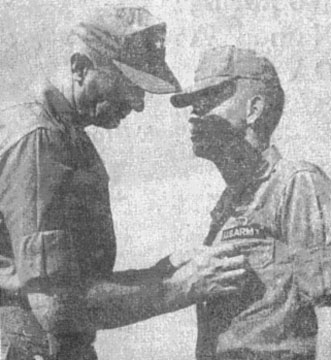 |
FOURTH HIGHEST – Major General Fred C. Weyand, division commander, decorates 2nd Lieutenant Dale R. Crafton, platoon leader, 2nd Battalion, 14th Infantry, with the Silver Star Medal. (Photo by Shibla) |
W’hounds Grab Arms, Supplies In S&D Move
The 1st Battalion. 27th Infantry, has ended an operation 23 miles southwest
of Cu Chi.
The “Wolfhounds” conduct ed the five-day search-and-destroy operation,
killing 14 Viet Cong and capturing six.
The battalion also captured seven weapons, including :a 1917 Winchester and a
Thompson sub-machine gun. In the sweep, the men added four bundles of
documents, gas masks, grenade launchers and 27 tons of rice.
They also captured three bags of medical supplies and three outboard motors.
In addition, 338 buildings, 134 sampans, 63 bunkers, eight foxholes and three
carts were destroyed.
Among the captured VC was a medic who, according, to Captain David N. Shaw of
Los Angeles, the battalion surgeon, was not equipped to treat a serious wound.
“The supplies he had were not sterilized and could be used only for special
situations,” Capt. Shaw said. One of the documents found revealed that the Viet
Cong in the area were in need of many supplies, especially morphine.
Company A discovered a small clay helicopter model, which was so complete it
showed the cockpit, door gunner, turbine engine and operational rotary blades.
Captain Lowell Mayone of Caugerties, N.Y., company commander, said because of
its detail, it probably was a VC training aid.
|
Bulletin!
|
Co. A, 1/27th, blasts Oriental River Activities
The Viet Cong navy and storage facilities on and near the Oriental River, 3.5
miles northwest of Saigon, suffered heavy losses recently as Company A, 1st
Battalion, 27th Infantry, “Wolfhounds” swept through the area.
Shortly after sunrise, the company’s rifle platoons dropped into three
separate areas on “eagle flights” (quick reaction helicopter assaults). Using
rubber rafts, the Wolfhounds searched the banks of the river and adjacent canals
and tributaries.
In four hours, 102 concealed sampans, 106 buildings, 42 bunkers and eight
tunnel networks were discovered and destroyed on the apparent VC infiltration
route into Hau Nghia Province.
Dropping into a nearby position, the “Wolfhounds” Company C caught ten
suspects and two Viet Cong.
The battalion reconnaissance platoon, on still another “eagle flight”,
swooped down on a group of Viet Cong, killing three and capturing four.
Cav. Hits B-Trap Hut
Division cavalrymen recently destroyed a Viet Cong booby trap factory and
captured a wide variety of enemy supplies four miles north of Cu Chi.
The operation was conducted by two platoons from Troop A, 3rd Squadron, 4th
Cavalry, along with units from 1st Battalion (Mechanized), 5th Infantry, and 2nd
Battalion, 14th Infantry.
The booby trap factory, discovered in a small hut, contained wire, explosives
and containers. The building was searched and destroyed.
Storage areas also were discovered in the sides of nearby trenches,
containing both black and green uniforms, a variety of ammunition and items of
Viet Cong field gear.
The men of Trp. A also found a Vietnamese newspaper with a picture of several
Viet Cong displaying American weapons. The newspaper named “Ngon Co Gia Dinh,”
had a Viet Cong flag on the front page and was dated June 15, 1966.
Several communist propaganda leaflets in English and Vietnamese were found,
exhorting the men of the 25th Division to put down their arms and go home.
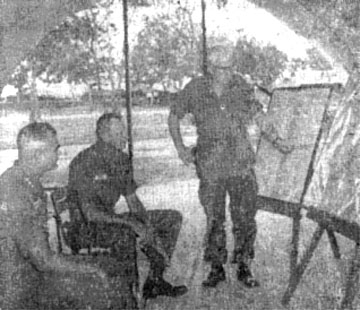 |
BRIEFING - Colonel Thomas M. Tarpley (right), 2nd Brigade commander, briefs General William C. Westmoreland, commander, Military Assistance Command, Vietnam, and Major General Fred C. Weyand, division commander, during the high commander’s visit to Cu Chi last week. |
Fanfare Opens Div. Ambush Academy
1st Class Hears COMUSMACV
The 25th Infantry Division has begun classes at Lightning Ambush Academy, a
unique innovation in anti-Viet Cong tactics.
Officially opened last weekend by General W. C. Westmoreland, commander, U.
S. Military Assistance Command, Vietnam, and Major General Fred C. Weyand,
division commander, the :academy will train maneuver battalion soldiers in
ambush and counter-guerrilla techniques.
The four-and-a-half-day program of instruction includes training in calling
for and adjusting fire support using special weapons, fundamentals in patrol
planning, day and night navigation, specific ambush and counter-ambush
techniques, writing patrol orders and carrying out an actual ambush patrol in
hostile territory.
The academy was built in two weeks by the 65th Engineer Battalion and
includes offices, classrooms, barracks and a mess hall. The capacity of the
school is expected-to triple in the next few weeks from 50 men to 150 men per
class.
Last week’s ceremony. conducted at the Cu Chi base camp included a briefing
by Captain Malcolm J. Howard of Deep Run, N.C., the academy commandant, and
remarks to the first class to enter the Academy by General Westmoreland.
Captain Howard said the school’s motto, ”Ingenuity, skill, aggressiveness”
are key factors in the new training program.
General Westmoreland, in emphasizing the need to master the technique of the
ambush, said, “We must be masters; of guerrilla tactics to a much higher degree
than the Viet Cong. We are going to out-guerrilla the guerrillas and out-ambush
the ambushers.”
General Westmoreland then proposed a fourth virtue be added to the academy’s
motto – discipline. “Discipline is all important to a counter-guerrilla
operation - discipline to carry out instructions to the letter and discipline to
hold fire until the last moment.”
Warning the students what they could encounter, the general added that the VC
have a standard plan for any attack – one slow step and four quick ones. The
slow step is painstaking preparation and rehearsal and the four quick ones are
attack and open fire, exploit and pursue, clear the battlefield rapidly and
withdraw rapidly.
Page 2 TROPIC LIGHTNING NEWS July 22, 1966
Decorated
| BRONZE STAR MEDAL (Posthumously) | |
|
PFC Michael F. Bingham, Co. A, 1/27th Inf. PFC Donald E. Byrum, Co. A, 1/27th Inf. PFC Ricky D. Castleman, Co. A, 1/5th Inf. PFC Gerald L. Crosby, Co, A, 1/27th Inf. PFC Harry R. Dyer, Co. A, 1/27th Inf. SP4 Carl E. Fell, Co. A, 1/27th Inf. |
PFC Tosado Pedro La Mourt, Co. A, 1/27th Inf. Sgt. Leslie I. Morales, Co. C, 4/9th Inf. Sgt. Russell L. Price, Co. A, 1/27th Inf. 2nd Lt. Lawrence F. Runey, Co. A, 1/27th Inf. Sp4 William H. Scheidt, Co. A, 1/27th Inf. |
| AIR MEDAL |
|
|
1st Lt. James V. Accardi, HH&S Btry., 1/8th Arty. WO Floyd E. Boyd, D Trp., 3/4 Cav. 1st Lt. Carl W. Burns, D. Trp., 3/4 Cav. Sp5 Wilson A. Esken, D Trp., 3/4 Cav. Capt. Valmore J. Girard, HH&S Btry.,1/8th Arty. Capt. Thomas J. P. Jones, HHC, 1st Bde. |
Maj. Michael J. Cubas, HHC, 1st Bde. Maj. Benjamin D. Roberts, Co. B, 25th Avn. Bn. Maj. Charles R. Sandidge, HHD, 25th Avn. Bn. Maj. Henry R. Schelton, HHC, 1st Bde. Capt. William R. Taylor, HHC, 1st Bde. WO Earl R. Wills, HHC, 1st Bde. |
| ARMY COMMENDATION MEDAL (With No Device) |
|
|
PFC James B. Barrett Jr., Co. C, 4/23rd Inf. PFC Patrick Caines, Co. B, 4/23rd Inf. PFC Marvin D. Harper, Co. B, 4/23rd Inf. SSgt. Donald H. Heskett, Co. C, 2/27th Inf. |
PFC Thomas F. McTurk, Co. C, 4/23rd Inf. Pvt. William Souders, Co. B, 4/23rd Inf. PFC William E. Vars, Co. C, 4/23rd Inf. |
| PURPLE HEART |
|
|
PFC Raymond Beauchman, Co. B, 2/27th Inf. PFC Girnie L. Brown, Co. A, 1/5th Inf. 2nd Lt. Richard W. Clark, Co. B, 1 /27th Inf. PFC Larry G. Cozart, Co. A, 2/27th Inf. PFC Charles A. Cronmiller, Co. A, 1/27th Inf. PFC Dyane O. Holt, A Trp., 3/4 Cav. |
PFC Herbert S. Jackson, Co. C, 2/27th Inf. Sgt. Joseph R. N. Labonte, A Trp., 3/4 Cav. PFC James L. Ledin, Co. C, 2/27th Inf. PFC Lorenzo C. Maulden, A Trp., 3/4 Cav. Sp4 Spreno E. Murkett, A Trp., 3/4 Cav. |
Endless Drill For VC.
Scholar or street urchin, professional officer or farm boy, they all tell the
same story of relentless Viet Cong indoctrination – of discipline playing on
every human emotion, constantly applied.
The soldier is required to memorize basic codes of conduct (a 10-point oath
of honor and a 12-point code of discipline) which put him in the position of a
hero, a patriot, a friend and protector of the people. He is never allowed to
forget this role. Perhaps the most effective reminder is his unit’s daily
indoctrination and self-criticism session. In this, his indoctrination is
continued and reinforced, his supposed motives are reviewed and discussed by the
group, and he is told by his leader what his future actions will be. After
this, he must explain his reactions, and he must publicly confess and criticize
his own shortcomings and weaknesses in thought and deed.
After every fight there is an almost immediate critique, with no holds
barred, giving every man a chance to let off steam. It also lets the cadre know
what his men are thinking.
This contributes to the effectiveness of the constant surveillance program,
maintained primarily through the cell system (usually three-man), which is
applied to every possible unit.
Appeals to the mind and the heart are the principal way in which the Viet
Cong seek to. control members. Regular units employ standard forms of military
courtesy, and strict obedience is always expected, but emphasis is placed on
making compliance with regulations appear to he voluntary.
For those who fail in their duty, if such normal punishments as public
criticism, extra duty and brief confinement do not bring reform, the penalty is
often discharge, in terms that make the man feel a traitor and an outcast from
the human race. The fear of corporal punishment or death seems to be of less
importance, although either may be visited upon the individual or his relatives.
Wooldridge Named As DA SMaj.
Sergeant Major William O. Wooldridge, formerly of the 1st Infantry Division,
has been named sergeant major of the Army, the recently created highest enlisted
position in the Army.
The Department of the Army (DA) announced its appointment at Pentagon
ceremonies one week after disclosing that the new position will serve as the
enlisted men’s liaison with the Army chief of staff.
SMaj. Wooldrige was selected from 4,700 senior enlistees throughout the
world. He had been sergeant major of the 1st Inf. Div. since last summer, and
holds the Legion of Merit for his performance as sergeant major of the 24th.
Infantry Division in Europe.
Duties of the sergeant major will be to advise and consult DA headquarters on
problems affecting enlisted personnel’s training, pay, promotions and morale.
He will present the enlisted viewpoint at DA staff meetings and represent all
enlistees at appropriate ceremonies.
Editorial
The Bell Still Rings
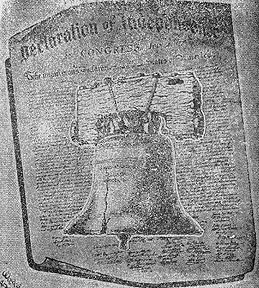 The Liberty Bell symbolizes one of America’s cherished treasures - the memory
of the day this great nation declared lasting freedom.
The Liberty Bell symbolizes one of America’s cherished treasures - the memory
of the day this great nation declared lasting freedom.
And it still rings loud and clear in America’s heart although no sound has
come from it for more than 130 years. Its history is interesting to all of us
for our heritage is closely woven into it.
The bell was cast in London. When hung at Independence Hall, Philadelphia,
in 1752, it broke at the clapper’s first stroke. It was recast by a local
bell-caster, but this time its tone was not up to expectations. Once again it
was melted down and a third bell formed. It was satisfactory.
Throughout events leading up to the American Revolution, the bell proclaimed
many occasions of joy and sorrow. In strict historical accuracy, the Liberty
Bell did not ring July 4, 1776. The motion for independence was unanimously
carried July 2. It was accepted by final vote on July 4 and the document rushed
to the printers.
Fifty-nine years later, in 1835, the Liberty Bell cracked while tolling in
honor of Chief Justice of the Supreme Court John Marshall, who had died.
Although it has never been rung since, the Liberty Bell still carries an
appealing note to all Americans. It symbolizes the day-the Fourth of July -
when an infant nation declared lasting freedom for her citizens.
The Liberty Bell is 2,080 pounds of ancient bronze hung from a beam of solid
hand-hewn black walnut. Around its crown are these words :”Proclaim liberty
throughout all the land to all the inhabitants thereof.” - Leviticus XXXV, 10.
It has been done.
Army OKs Automatic Boosts For 20-Year E-5, E-6 Vets
Department of the Army has announced new regulations to permit the automatic
promotion of enlisted personnel in pay grades E-5 and E-6 with over 20 years’
service.
According to the message (772228 from DCSPER), 105 critical skills are
included in the provision, including individuals working in the Corps of
Engineers, Medical, Ordnance and Signal Corps.
Promotion requirements in effect for other pay grades and skills have been
eliminated under the new provision. Eligible individuals need only the
recommendation of their unit commanders to receive promotions to the next higher
grade.
DA added that allocations normally required are not necessary, with all
promotions being automatic and not dependent upon Army-wide, quotas.
Anyone to be promoted under the arrangement must serve an additional two
years on active duty before being considered for voluntary retirement.
Most of the 105 skills listed are in technical fields ranging from bridge
specialist, medical specialist, wheel and track vehicle mechanics and field
radio repairman to teletype-writer repairman, telephone switchboard operator and
still photographer.
Most of the critical skills are open for promotion to both E-6 and E-7,
although some are restricted to one pay grade or the ether.
| The TROPIC LIGHTNING NEWS is an
authorized publication of the 25th Infantry Division. It is published
weekly for all division units in the Republic of Vietnam by the
Information Office, 25th Infantry Division, APO U.S. Forces 96225. Army
News Features, Army Photo Features and Armed Forces Press Service material
are used. Views and opinions expressed are not necessarily those of the
Department of the Army. Printed in Saigon, Vietnam, by Saigon Daily
News. Maj. Gen. Fred C. Weyand . . . . Commanding General Maj. William C. Shepard . . . . . . Information Officer 1st Lt. William H. Seely III . . . . Officer-in-Charge Sp5 Dale P. Kemery . . . . . . . . . Editor PFC David L. Kleinberg . . . . . . Editorial Assistant |
Page 3 TROPIC LIGHTNING NEWS July 22, 1966
VC Huddle Loses Ball Game
The 20-year-old, with just a month in grade as sergeant, stood stiffly at
attention at Bao Trai as the division commander pinned the Bronze Star for valor
on his mud-and sweat-stained fatigues
Sergeant Michael A. DiSanto of Philadelphia, Pa., was tired. It had been a
long night but six Viet Cong guerrillas were dead, one captured, and Major
General Fred C. Weyand, division commander, was commending him for leading a
successful ambush.
Just 12 hours before, he had left the perimeter of Company B, 1st Battalion,
27th Infantry, going east toward the Oriental River. The operation called for a
night ambush to be set up on a road 600 yards away.
Perimeter
As he left the perimeter in the waning light, Sgt. DiSanto took the point.
With. him were 16 members of his platoon.
Since a VC battalion was thought to be in the area, the new platoon leader,
2nd Lieutenant Frederick F. Roark of Logansport, Ind., decided to go along,
taking with him Staff Sergeant Roscoe W. Frazier of Washington, D.C., Sgt.
DiSanto’s old squad leader and newly named platoon sergeant.
Darker
It got darker as they moved to the ambush position. By 9 p.m., they were
moving parallel to a road, their eventual destination, which was about 50 yards
to the right across a small canal.
Sgt. DiSanto stopped suddenly. A few yards down the road, four VC were
walking toward him. As the squad leader turned to halt the patrol, Sgt. Frazier
spotted five more VC moving toward the first group, also on the road. Silently,
the 17 men melted into a linear ambush as the two groups of guerrillas met.
“They stopped right there in the middle of the road and began chattering in a
football-like huddle,” explained Lt. Roark. “They were at the dead center of
the patrol and right in front of me, about 50 yards away. It was just a matter
of seconds when Sgt. DiSanto spotted them, and I opened fire to signal the
attack,” he continued.
A Tracer
“The lieutenant fired the first round, a tracer,” said Sgt. DiSanto. “It hit
a VC rifle grenade.”
“lt exploded and we all opened up with all we had.”
“With all our firepower going into them, their huddle began collapsing until
the area was flat.”
Back at the battalion base, Staff Sergeant Ronald W. Kittrell of Daytona
Beach, Fla., began to receive fire requests for his 81mm mortar section. “We
heard the ambush. go off,” he said, “and in no time Sergeant Roche (Sgt. Leo F.
Roche; of Philadelphia, Pa.) was calling for fire.”
While more than 50 rounds of mortar fire were going out, 105mm artillery was
called in.
“We were pretty sure we got them,” explained Sgt. DiSanto, “but we wanted to
seal off the area with fire in case any got away.”
Moving back about 100 yards, Sgt. DiSanto placed the squad in the defensive
perimeter and kept the road under surveillance.
“I decided to stay out there and wait until morning,” he said. “Usually it’s
so disappointing. You spring what you know is a good ambush and in the morning
the bodies are gone.
Light
“I thought it was going to happen again, but at first light we moved up to
the road, set up security, and sure enough, the bodies were there.”
Along with the bodies, the soldiers collected a Thompson sub-machine gun,
three carbines and two rifles. Six rifle grenades, two rifle grenade launchers,
two pistol belts and assorted ammunition and documents also were picked up in
the area.
Back at the base camp, Sgt. DiSanto learned that the, battalion
reconnaissance .platoon had made a detailed check of the area and captured a
wounded VC. He had been one of those ambushed he said, and was on his way with
his squad to reconnoiter the U.S. positions.
Just 12 hours after leaving for his second ambush as patrol leader, Sergeant
Michael DiSanto was ‘back, wearing the Bronze Star for valor.
|
C&GS Visitor |
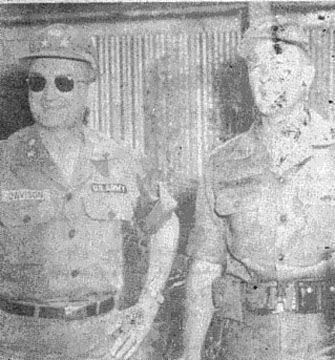 |
| Major General Michael S. Davison, commandant of the U.S. Army Command and General Staff College, and Major General Fred C. Weyand, division commander, pause during General Davison’s recent visit to the Cu Chi base camp. The visit included a briefing on the present tactical situation as well as a tour of one of the operational areas. (Photo by Park) |
Spt. Cmd. Boosters Help Minh Tan Kids
The division Support Command at Cu Chi has donated more than 130,000
Vietnamese piastres during the last few months to the village of Minh Tan School
in Bac Ha I.
Like many villagers who have suffered under Viet Cong terrorism, those of Bac
Ha I have been left without means of supporting themselves. Realizing the
people’s plight, the men of Support Command decided to help the villagers in
every way possible.
The Minh Tan I School, a combination elementary and secondary school built 10
years ago by the French newspaper “Fiagaro” and the Catholic Church, has become
one of Support Command’s chief projects.
In May, just one month before the school year was to start, Colonel Herbert
S. Lowe, commander of Support Command, received a plea for financial assistance
from the Minh Tan School’s headmaster, Father Tran Van Phan.
The headmaster explained that is was impossible for the majority of the
students to pay the tuition required by the school. Without a suitable income,
the school could not hire enough teachers, forcing a decrease in the number of
classes.
Col. Lowe and the officers in his command immediately agreed to seek
donations for the school. Within a month, Support Command personnel had
contributed 44,000 piastres, and had agreed to donate the same amount every
month.
The school, now running smoothly, has an enrollment of 428 students,
including 230 elementary and 198 secondary or high school students.
Elementary courses include arithmetic, history, geography natural science,
Vietnamese and English. The secondary school curriculum offers biology,
chemistry, physics, mathematics, Vietnamese and English.
The English department, now a successful addition to the school’s scholastic
program, was initially suggested by the men of Support Command, with the thought
that it might promote a better understanding between American forces and the
Vietnamese people.
Capt. Hugh H. Richardson of Framingham, Mass., civil affairs officer, teaches
secondary school-age children English, American geography and history.
| NO HARD FEELINGS - PFC Eddie D. Jarrett, of 1st Battalion, 27th Infantry, hands a soft drink to a Viet Cong prisoner who survived an ambush by Company B the night before. The ambush took place last week 23 miles southwest of Cu Chi. (Photo by Goodrich) |
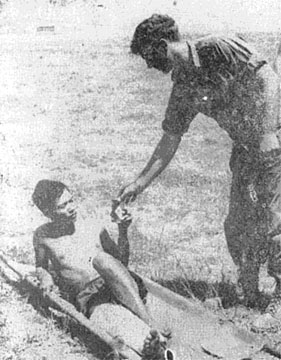 |
Page 4 - 5 TROPIC LIGHTNING NEWS July 22, 1966
Life at a Busy Base Camp
 |
| SUPPLY - PFC Ernest L. Brown of Houston issues a crate of ice-cold oranges to Specialist Four Harry R Greene of Lake Stevens, Wash. The oranges are part of the daily food ration for the 322nd Engineers. |
|
Photos By Seely And Pardue |
| FUEL - This gasoline-driven pump speeds the flow of fuel for the division. Specialist Four Joseph Lane of Jacksonville, Fla., dispenses hundreds of gallons of fuel daily. At the petroleum, oil, and lubricant yard located at Cu Chi, collapsible tanks (shown in background) are used for the fuel storage. |
 |
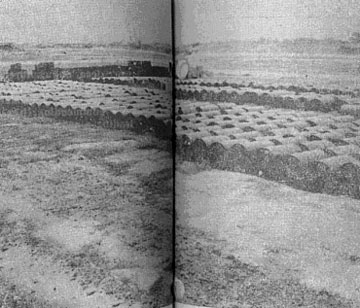 |
OIL YARD – Fuel storage tanks ranging in size from five gallon to fifty five
gallon, play a major role in the storage of gas, oil, and lubricants used by the
division. [Photo was placed across the center fold, and this bound volume could not be opened wide enough to scan the complete photo...] |
MAINTENANCE – Two UH-1B helicopters received similar damage during combat
assault missions when enemy fire penetrated the plexi-glass bubbles and
continued through sections of the undercarriage. Specialist Four Ronald W.
Lawrentz of Akron, Ohio, performs corrective maintenance on a “Centaur” huey
(left of Company A, 25th Aviation Battalion, while Specialist Five Kelly of
Brooklyn, N.Y., repairs the “Centaur” huey of the 3rd Squadron, 4th Cavalry.
[Photo not available; placed across center fold of paper, which could not be
fully opened because it was in a bound volume]
UP TO PAR – These two trailers containing compressors are a small part of the
complex equipment on hand at Company D, 25th Maintenance Battalion. The
maintenance battalion keeps the aircraft of the 25th Aviation Battalion and
Troop D, 3rd Squadron, 4th Cavalry, repaired and ready to go. [Photo not
available; placed across center fold of paper, which could not be fully opened
because it was in a bound volume.]
| CALCULATION - Two Division Supply office clerks, Specialist Four Van J. Espy of Birmingham, Ala., and Specialist Four Carl E. Kerns of Higgins Luke, Mich., sort and file requisition cards. The IBM cards simplify the task of supplying the division. |
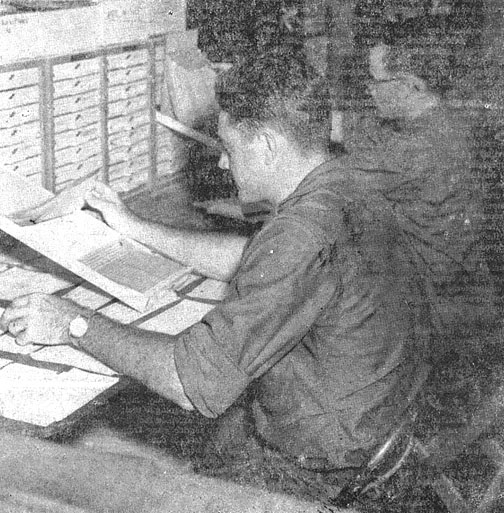 |
 |
GET TOGETHER – Members of the 25th Aviation Battalion relax with a game of volleyball during a recent gathering. The men held a luau in the “Little Bears” area, giving them their first chance to be together since coming to Vietnam because of operations. |
Page 6 TROPIC LIGHTNING NEWS July 22, 1966
1/27th Helps Refugees In Exodus From V.C.
The 1st Battalion, 27th Infantry, evacuated 358 refugees by helicopter during
a recent operation southwest of Cu Chi.
The operation began in an attempt to verify rumors of Viet Cong-held American
prisoners in the area beyond the Oriental River, about 40 miles northwest of
Saigon.
Although the rumors proved unfounded, the “Wolfhound” assisted victims of VC
terrorism.
The Oriental River was once considered so safe that guerrillas had set up
rest and recuperation camps and a field hospital.
The villagers had no way to cross the river until division soldiers provided
the security and means for their escape.
As the soldiers swept the operational area, repeatedly they found families
hiding in shelter holes fearing the guns of the helicopters. When the
helicopters left, the people came out with all their belongings packed, ready to
go.
They needed no encouragement to leave and resettle in a Vietnam-sponsored
“New Life” hamlet.
Temporarily, the people have been quartered in unused barracks at the Hiep
Hoa sugar mill. The barracks were originally used for dependents of the
National Police.
The people will be processed by province officials. Until the processing is
completed, they can receive no aid from the government. To fill the “red tape”
gap, the 25th is providing assistance.
“Helping Hand” items of food and clothing are being distributed along with
U.S. Agency for International Development (USAID) items such as cooking
utensils, cooking oil, clothing and food.
Once the processing is completed, the refugees will receive a 3,500$ VN
relocation allowance, a tract of land and USAID commodities.
Company B, 1st Battalion, 27th Infantry, did most of the evacuation work.
Platoon Sergeant Leslie Crawford of Goldsboro, N.C., said everyone he met was
willing to leave.
Co. B. First Sergeant George T. Almeida of Waianae, Hawaii, said, “Tangible
results on this operation lifted the morale of the entire unit. They felt they
were really doing something and hounded their platoon sergeants for a chance to
go out and find some more refugees.”
One group of people, so insistent on leaving when no helicopters could be
found, packed their supplies and fell in step with the soldiers until a chopper
could come for them.
Shuttle Bus Welcome At Airfield
The little blue bus running around Cu Chi looks like an ambulance and it
should. The old ambulance, reconditioned and painted the division’s colors, now
serves as a shuttle bus, a cheery blue speck in the midst of a mass of olive
drab. It has already become a familiar, welcome sight to foot-weary travelers.
The base of operations for the re-commissioned ambulance is the Cu Chi Army
Airfield, where more than 100 passengers a day land with no way of going to
their destinations except on foot.
Shuttle service runs from 7:30 a.m. to 5:30 p.m. each day. On a busy day,
the bus carries upward of 100 passengers and logs more than 50 miles just
traveling around base camp.
| PIONEER - PFC Melvin L. Lyons of Lynchburg, Va., handles a portable saw as the 65th Engineer Battalion clears foliage about 90 miles northeast of Saigon. The area is scheduled for use as a base camp for the 52nd Regiment, Army, Republic of Vietnam. (Photo by Shibla) |
 |
25th Marks July 4 In Vietnamese Village
The Fourth of July, normally a day reserved for American celebrations, took
on a picnic atmosphere in the Vietnamese village of Bac Ha I, just outside the
division’s base camp. The Vietnamese may not have understood fully the
significance of the day, but the band played and the firecrackers popped as
Support Command staged the Independence Day show.
The division band opened the festivities with a concert, followed by Colonel
Herbert S Lowe, Support Command commander, who lit a string of firecrackers
which were raised up the Minh Tan School flagpole.
The colonel and the village chief addressed the villagers and the smartly
uniformed school children.
Following the address, Support Command members distributed toys and other
items to the children.
The day reached a high point when volleyball and soccer games were held
between teams from Support Command and a team of the Vietnamese Popular Forces.
The division has been conducting Medical Civic Action Program visits and
providing financial support to the school and village since last March.
Boots Bought
The Department of Defense is buying 2,881,800 pairs of combat boots from 11
firms at a cost of $31,314,180. The firm fixed-price contracts were awarded by
the Defense Personnel Support Center, Philadelphia, Pa., a field activity of the
Defense Supply Agency.
Persuasion Triumphs In ‘Fort Smith’
A writer once noted, “It may take forever to win men’s minds by persuasion,
but that’s quicker than you can do it by force.”
The men of 2nd Battalion, 14th Infantry, probably never read that passage,
but they did, nonetheless, try to put it into effect on the recent Operation
“Fort Smith”, an operation designed to pacify and encourage villagers to accept
American assistance.
Relocated at Trang Bang District, 20 miles northwest of Cu Chi, the 2/14th
prepared for a 30-day operation, led by Major Peter Kama, in charge of field
operations and planning.
The Vietnamese-speaking Maj. Kama planned the operation with the district
chief, who said that he was responsible for 10 villages, three of which which
were protected and ruled by the government.
The others, more distant, were reportedly infiltrated with VC. The chief
said the villagers had been told Americans would take their land, destroy their
homes and eat their babies.
Ap An Phu, described by the chief as a wealthy village with about 1000
families, was one of the villages and it was pacified.
On its first visit, the 2/14th found the village deserted, the people
apparently hiding out of fear.
But when the Americans left and the villagers returned, they found their
homes and crops untouched, not destroyed as the VC had told them.
A few days later, the unit revisited the village. Prior to its arrival it
air dropped leaflets explaining its purpose for being in Vietnam. The leaflets
also stated that the villagers should continue their daily activities when the
Americans enter for, if they were not VC, they were completely safe.
On this second visit, the 2/14th found many villagers were beginning to trust
them
The Americans announced to the villagers they had a doctor with them and
would be happy to see any sick or injured. The villagers were hesitant but a
few agreed to treatment.
Again the infantrymen left the village alone for a few days and continued the
same procedure on other surrounding villages. After about a week, the unit
returned. This time half of the population had remained and when the call for
medical assistance went out the villagers were waiting.
As before, leaflets were dropped and this time the district chief spoke to
the people. He told them that they would no longer have to give up their crops
to the VC nor would they have to fear them.
By word of mouth the news spread to the surrounding farms and villages, and
when the men of the 2/14th visited the fourth time, more than 99 per cent of the
villagers were present. The 2/14th treated the sick and passed out daily
necessities. In all, they treated more titan 900 patients. They passed out
milk, clothing, sugar, tooth brushes and soap to more than 2, 000 villagers.
As the villagers received help, they lost their fear. They told of the
location of many mines and booby traps set by the VC.
Even the children helped. Three disclosed the names and location of Viet
Cong living in the area. Another gave the location of a VC ambush platoon.
The villagers began to accept the Vietnamese government once it was fully
explained, and more than 230 families left their farms and - relocated in the
villages controlled and protected by the government.
For the men of the 2/14th, the month was long and seemingly uneventful, but
psychologically they had won a. major battle.
Cu Chi Village Builds With 3/13th Supplies
The long deserted village square at Tan An Hoi near Cu Chi, now bustles with
the activities of school-age children.
What once was a grassy mall has been converted into a community playground
through a self-help program initiated by Battery C, 3rd Battalion, 13th
Artillery.
As soon as a site was selected, the battery scraped together the scarce
supplies and gave them to the villagers.
Major W. Glen Emery of Valparaiso, Ind., civil affairs officer for Division
Artillery, coordinated the project between U.S. officials and the hamlet chief,
Ngo Xuan Truong.
The villagers themselves built the entire playground measuring some 35 by 70
yards. In a few weeks the villagers had completed the first such self-help
project in the province.
Steel piping, cement and wood went into the tree house, two seesaws, monkey
bar, overhead ladder and four swing sets, that now generate squeals and laughter
from the 500 children who clamber around the playground everyday.
4/23rd Aids 1st Division
The division’s 4th Battalion 23rd Infantry, recently completed one month’s
duty as a reactionary force for a 1st Infantry Division operation in one more
example of cooperation between major units.
Elements of the 4/23rd spent 35 days on a hillside rear Long Binh, outside of
Bien Hoa. while the “Rig Red One” swept a nearby area.
Page 7 TROPIC LIGHTNING NEWS July 22, 1966
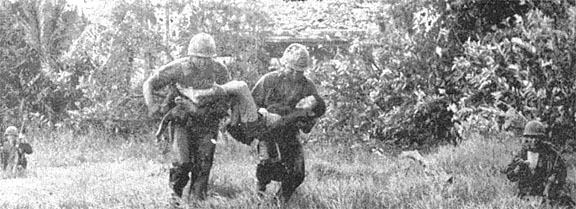 |
| WAITING - Members of 2nd Battalion, 27th Infantry, carry a wounded VC suspect to a waiting helicopter for evacuation to Cu Chi, where he was treated, then turned over to Vietnamese provincial officials for questioning. (Photo by Seely) |
W’hounds Grab Big VC Cache
The hit-and-run tactic is a favorite way of warfare for the Viet Cong, but
elements of 2nd Battalion, 27th Infantry, recently turned the tables on the
elusive VC.
Through a series of maneuvers, the “Wolfhounds” seized a VC arms cache, along
with documents which appeared in a marshy area south of Cu Chi.
The first element of Company C to land was a reinforced squad which came
under immediate VC fire.
The “Wolfhounds, advancing under heavy enemy fire, worked their way across
the marsh toward a building half hidden in the tree line, while armed
helicopters laid down a barrage of aerial firepower.
The squad reached the tree line, entered the building and found the arms
cache which the fast-retreating VC had left behind.
The squad searched the building, finding four rifles, one radio, two cases of
Russian-made ammunition, 73 fragmentary grenades, two mortar sights, 1,600
rounds of small arms ammunition, 300 rounds of .30 caliber ammunition, six bags
of gun powder, 18 TNT blasting caps and nine pounds of documents.
Upon the completion of the search, the squad was evacuated and a second was
dropped east of the first landing zone. Three squads alternated during the rest
of the day in maneuvering through the area.
Textbook Case
Xom Hue Pacified
Descriptions of pacification of the Hau Nghia Province hamlet of Xom Hue read
like textbook examples at a civil affairs counsel.
The pacification program is divided into three stages. The first is
coordination between local civilian officials and U.S. military officials. This
phase was easily accomplished at Xom Hue. Everybody concerned was more than
happy to cooperate.
Stage two, the critical phase of the operation, saw American military
personnel expose themselves to the villagers for tile first time, a time when
the people are either won or lost.
Captain James D. Kimball of Osceola, Ind., surgeon for 25th Division
Artillery, inaugurated the second phase with a Medical Civic Action Program (MEDCAP)
visit during which he treated 139 people. Capt. Kimball is continuing the
visits on a bi-weekly basis. He treats an average of 110 patients a visit.
On the day of the first MEDCAP, other division soldiers distributed 1,300
pounds of Catholic Relief Society clothing and food to 280 families - about
1,400 people.
The people, at the beginning of stage two, were skeptical. They had seen
soldiers before, but they were not particularly fond of foreigners with weapons.
But American spirit and medical treatment, food and clothing convinced the
villagers that Americans were there to help them.
The people invited U.S. military officials and the village chief to eat with
them and see their homes. Major W. Glenn Emery, Div. Arty. civil affairs
officer of Valparaiso, Ind., and Ngo Xuan Truong, the village chief, turned down
more invitations than they could accept.
Mothers and fathers now have enough confidence in American ability to provide
for their personal safety that they increasingly come to tell of Viet Cong
tunnels or booby traps.
Maj. Emery considers phase two a success and has just begun phase three,
providing security on a round-the-clock basis. The division is helping to build
an outpost and two listening posts to be manned by members of the local Popular
Force soldiers. These men are being organized and trained under the direction
of the village chief.
Once phase three is completed, the pacification program will be finished.
American support will not end with the completion of the program, though.
The MEDCAPs and distribution of food, clothing and assistance will continue.
Xom Hue is well on the way to becoming a living, working part of an organized
society - in just three easy stages.
Artillery Can’t Kill Movies
As the sun sets and the roar of the artillery fills the night at Cu Chi, the
movie projectors are made ready to provide entertainment to the division’s
thousands of men.
In unit theaters throughout the camp, recent feature films, most in color and
many in wide-screen, begin showing as soon as darkness falls.
Screens range from makeshift assemblies of scrap lumber to huge plywood
panoramas that may rival a Hollywood theater. They all have one thing in common
- they were built by the men in their spare time with whatever materials were
available. The seats too are varied in these open-air theaters. Fold-up chairs
are few but the men don’t mind. They find seats, whether on a truck, a box or a
square foot of ground.
Sergeant Jimmy C. Ridenour of Rockwood. Tenn., a management specialist with
25th Administration Company during the day and a volunteer projector operator at
night, said the men “not only watch the film, but almost become the actors.”
“They root for the heroes and boo the villains,” he said. “They talk love to
the actresses, and laugh hysterically at the comics. They love it, every bit of
it.”
So each night as flashes from the bombs and shells light up Cu Chi’s
perimeter, and helicopters buzz around above them, those fortunate men of the
25th not on patrol or guard duty sit, almost at home, and enjoy movies almost as
they would at a drive-in 8,000 miles away.
Ace in the Hole
Twelve unusual decks of playing cards for use in psychological warfare
against the Viet Cong have been delivered to the division by Rep. John J.
Gilligan of Ohio.
A casual glance at the decks would turn up nothing unusual, but closer
inspection would show them to be unique - all 52 cards are aces of spades.
Rep. Gilligan delivered the cards on behalf of Allison Stanley of the U.S.
Playing Card Company, Cincinnati, who had heard that the Viet Cong are
superstitious of the ace of spades.
Men of the 2nd Battalion, 35th Infantry, at Pleiku used the black aces for
the first time last April, posting them conspicuously in their areas of
operation.
Since then their supply of cards has been replenished.
| UN-BOOBY TRAP - Carefully taping an explosive charge to the barbed wire, Staff Sergeant Paul G. Hamel of Cumberland, R.I., squad leader from Company A, 65th Engineer Battalion, prepares to destroy a Viet Cong booby trap during a recent operation. (Photo by Shibla) |
 |
“Old Soldiers’ Home” Ready for the Young
Far from the sedate atmosphere of most homes for the aged, the “Old
Soldiers’ Home” of the 4th Battalion, 23rd Infantry, was constructed for the
young.
The recently completed club is part of a general “redevelopment program” at
the “Tomahawks’” base camp location. Volunteers have been working on living
quarters and buildings for the men’s relaxation.
The men feel that any respite from the war and the climate is worth the
effort.
A corrugated iron roof, a lanai (porch) complete with easy chairs, indirect,
multi-colored lighting, and a well-supplied bamboo bar are the main features of
the “Old Soldiers’ Home.” Playmates adorn the walls.
Corrugated roofs are also being added to many of the living quarters in the
battalion area to make them cooler.
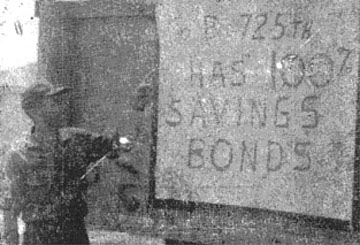 |
ALL THE WAY - First Sergeant Mety Davis of White Sands, N.J., points out the sign displaying Company B, 725th Maintenance Battalion’s 100 per cent participation in the Savings Bond program. The unit was the first company to claim the distinction in the division. (Photo by Williams) |
Page 8 TROPIC LIGHTNING NEWS July 22, 1966
Announcing . . .
The 25th Infantry Division’s 25th Anniversary Pictorial Review Book
The 25th’s 25th . . . in Combat
Order- Now
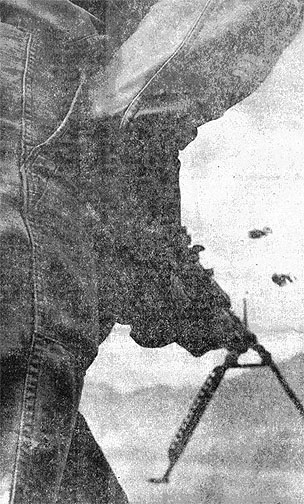 In commemoration of the silver anniversary of the 25th Infantry Division
on Oct. 1, 1966, a pictorial review book will be published for distribution on
the anniversary. Cost of the book is $5 and includes prepaid delivery within
the United States. To order a copy, contact your unit project officer or the
Information Office, 25th Infantry Division, APO San Francisco 96225. Units will
conduct sales on payday,. July 31.
In commemoration of the silver anniversary of the 25th Infantry Division
on Oct. 1, 1966, a pictorial review book will be published for distribution on
the anniversary. Cost of the book is $5 and includes prepaid delivery within
the United States. To order a copy, contact your unit project officer or the
Information Office, 25th Infantry Division, APO San Francisco 96225. Units will
conduct sales on payday,. July 31.
Unit Section . . .
All units of the division will be featured in a special section with pictures
of your outfit in combat in Viet Nam.
Roster Section . . .
Active duty members of the division will have their names included in the
roster section, to appear in 40 pages of the publication, along with pictures
taken of the division in Vietnam.
Military Operations . . .
Hundreds of pictures have been selected to portray division activities on
military operations in Vietnam in several sections of the book. Remember
Operations “Honolulu,”, “Makaha,” “Wahiawa,” “Maili,” “Fort Smith,” “Garfield,”
“Lincoln,” “Longfellow,” and “Paul Revere”?
Base Camp Features . . .
Division activities in base camp at Cu Chi and Pleiku are included to portray
what “Tropic Lightning” soldiers have undergone since their arrival in Vietnam.
2nd Bde. Gets RVNAF Plaque
“The Armed Forces of the Republic of Vietnam representing the people of free
Vietnam appreciate your heroic and unselfish action in joining free Vietnam in
resisting aggression by a common enemy.”
The words are inscribed on a plaque presented to Colonel Thomas M. Tarpley,
brigade commander.
The plaque is one of many that Lieutenant General Cao Van Vien, chief of the
Joint General Staff, Republic of Vietnam Air Force, is awarding to all brigade
and group-sized units of the Free World forces serving in Vietnam.
The plaque is emblazoned with a coat of arms, which depicts the symbols of
various military units. General Cao’s message is etched in brass on the bottom
of the plaque.
Lieutenant Colonel Charles R. Leach, assistant advisor to the Political
Indoctrination Department, Military Assistance Command, Vietnam, delivered the
plaque to Col. Tarpley for General Cao.
65th Builds Tower
The 65th Engineer Battalion at Cu Chi has erected a 10,500-gallon potable
water tower in the battalion area.
The standard type tower is one of three the engineers will build to supply
the entire base camp. A second is now under construction in the vicinity of the
2nd Battalion, 14th Infantry battalion area, on the northern end of the base.
Sergeant Troy L. Michen, the battalion’s water purification NCO from
Gainesville, Fla., said the tower is supplying 25,000 gallons a day from a well
next to it.
The water is pumped into a purification van where it is processed and
filtered for drinking before being. Pumped into the tower.
The tower is about 17 feet in diameter and nine feet tall. It stands on an
18-foot square platform, which is ten feet off the ground.
Water rationing at Cu Chi is expected to be eliminated when the three towers
are fully operational.
Thanks to:
The 25th Infantry Division Museum for providing the volume of 1966 Tropic
Lightning News,
Ron Leonard, 25th Aviation Battalion for finding and mailing them,
Kirk Ramsey, 2nd Bn., 14th Inf. for creating this page.
This page last modified
08-07-2007
©2007 25th Infantry Division Association. All rights reserved.